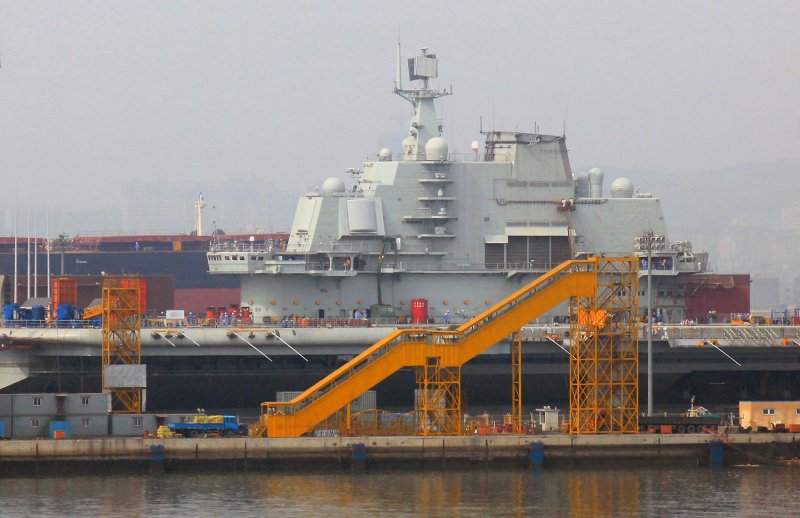1 of 3 | China's new Russian-built aircraft carrier sits in dry dock, after completing a series of sea trials earlier in the month, in the country's northeast port city Dalian on August 29, 2011. The carrier, a retrofitted ship called the Varyag, has long been seen as the first step in China's plan to eventually build a handful of carriers as part of a wider strategy to develop its naval might. UPI/Stephen Shaver |
License Photo
LONDON, Oct. 3 (UPI) -- An ugly momentum is building in the South China Sea, where an official Chinese newspaper called last week for war against Vietnam and the Philippines to uphold China's assertion of sovereignty over the mineral-rich seabed, estimated to hold 7 billion barrels of oil and 900 trillion cubic feet of natural gas.
The lead article in the Chinese Communist Party newspaper Global Times
Tuesday carried the headline "The time to use force has arrived in the South China Sea; Let's wage wars on the Philippines and Vietnam to prevent more wars."
"The South China Sea is the best place for China to wage wars," the article said. "Of the more than 1,000 oil rigs there, none belongs to China; of the four airfields in the Spratly Islands, none belongs to China; once a war is declared, the South China Sea will be a sea of fire [with burning oil rigs]. Who will suffer the most from a war? Once a war starts there, the Western oil companies will flee the area, who will suffer the most?"
The article went on to argue that "the wars should be focused on striking the Philippines and Vietnam, the two noisiest troublemakers, to achieve the effect of killing one chicken to scare the monkeys."
The Global Times is China's main newspaper for international affairs, widely distributed internationally in English, and is published under the authority of the central committee of the Chinese Communist Party. The article also argued that the United States wouldn't intervene, too preoccupied with its war on terror, its quagmire in Afghanistan and its own economic problems.
There were three immediate triggers for the extraordinary reaction from Beijing.
The first was the successful move by the Philippines to arrange talks within the Association of Southeast Asian Nations, excluding China, on cooperating and "clarifying consensual and disputed claims in the South China Sea."
The second trigger was India's rejection of Chinese objections to its own new agreements to explore for oil in Vietnamese waters, in partnership with Vietnam. Global Times had criticized the Indian approach, saying in an editorial that Vietnam's efforts to bring in foreign companies to explore for oil amount to a "serious political provocation."
India hasn't been intimidated.
"We will proceed with drilling at our block (in the South China Sea) on a schedule established according to our technical convenience," India's Oil and Natural Gas Corp. announced last month, adding that India's foreign ministry had told ONGC the area where the oil firm wished to explore was "very much inside Vietnam's territory."
The third trigger was last week's agreement of Japan and ASEAN, at a meeting of defense officials in Tokyo, to intensify cooperation and consultation on the South China Sea. Japanese Vice Minister of Defense Kimito Nakae said the relationship between Tokyo and ASEAN has "matured from dialogues to one where Japan plays a more specific cooperative role" on a range of regional security issues."
Nakae also suggested that the recent tensions over oil exploration and military posts in the South China Sea would require more cooperation with the United States and other countries, including India.
Immediately before the defense officials met, Japan and the Philippines affirmed their security links into a "strategic partnership" in a joint statement signed by Prime Minister Yoshihiko Noda and Philippine President Benigno Aquino in Tokyo.
"Chinese naval activism will not likely be a temporary phenomenon but will be a permanent feature of Asian politics in the years to come," commented Toshi Yoshihara, a professor of Asia-Pacific studies at the U.S. Naval War College. "Maritime Asia is going to be a busy place. It is going to be a busy theater as China fulfills what it believes is its rightful maritime prerogative."
China's decision to steer more of its growing economic strength into defense spending and a regional naval buildup, including a new aircraft carrier and submarines, has given weight to Beijing's rhetoric over its rights to the South China Sea.
Former Philippines President Fidel Ramos, visiting Washington last week, indicated that the real issue would be U.S. readiness to deter China and support the rights of smaller nations.
"We expect South China Sea tensions to continue because the root cause is really China's perceived need to break out from under the strategic dominance of the Western allies," Ramos said. "China's proximate aim, it seems to me, is to limit American freedom of access" and "erode the credibility of Washington's security guarantees to the East Asian states, including and especially the Philippines."
The Pentagon plans to boost its presence in the region by strengthening the military capability of its air, naval and marine bases in Guam are in question because of plans to cut the defense budget. The plans include a new aircraft carrier berth, submarine and logistics bases, facilities for more stealth warplanes, B-2 and B-52 bombers on Guam and to move 8,600 U.S. Marines to the island.















